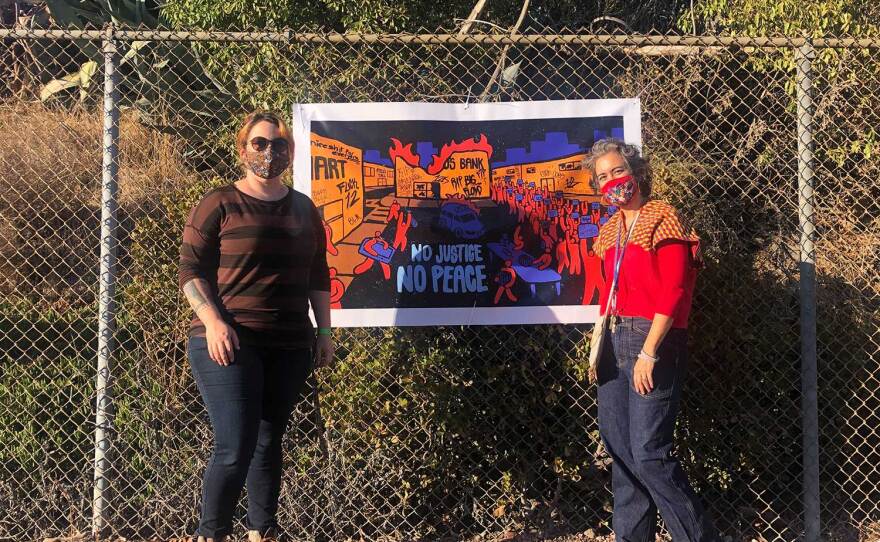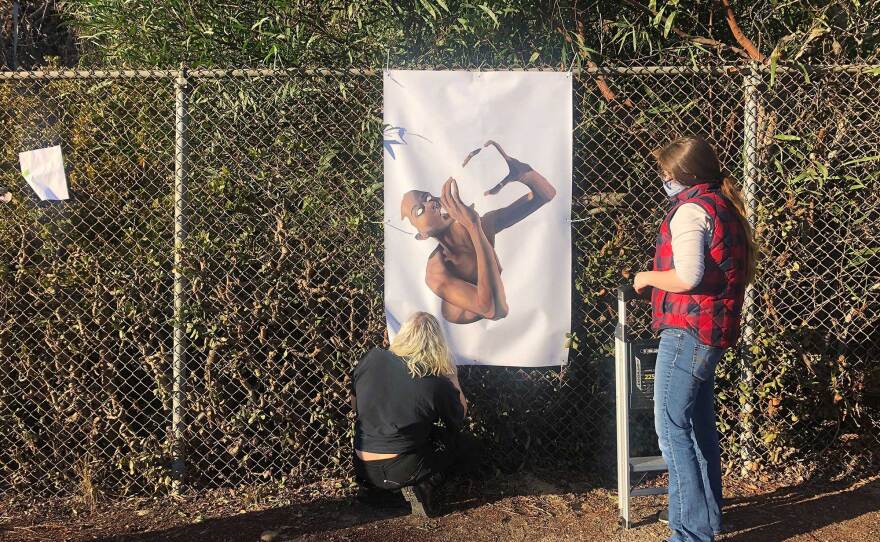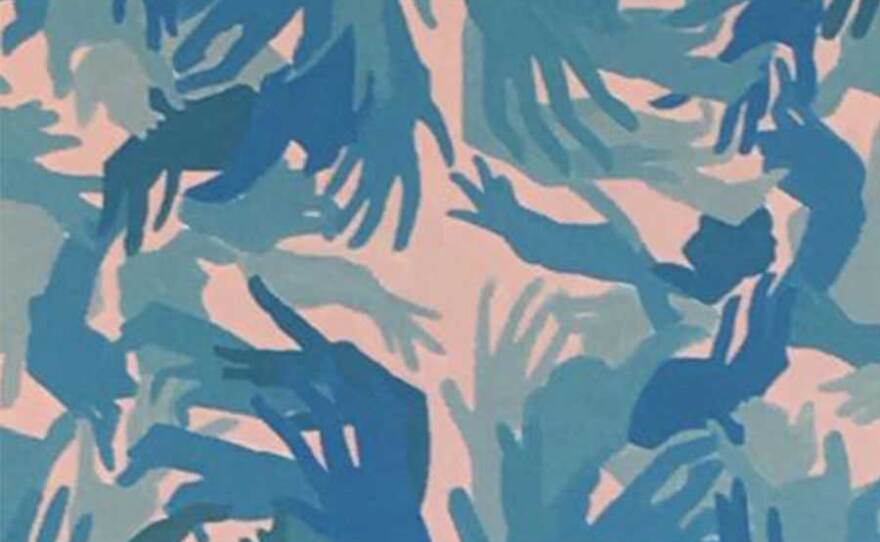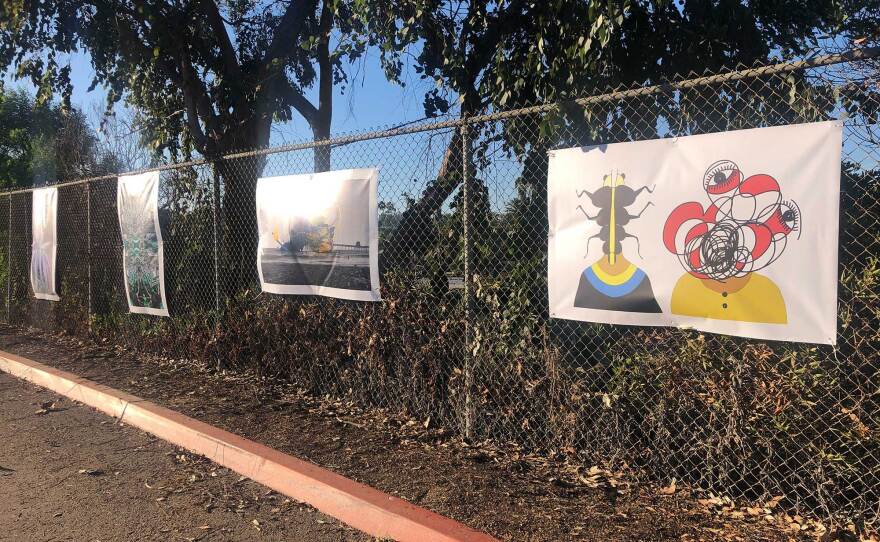On a sunny but brisk November afternoon, a small group of masked people affixed dozens of 3 x 5 foot art banners against the chain link fence of Parking Lot 1 at San Diego Mesa College. Each banner features original artwork by artists such as Bhavna Mehta, Lourans Mikhail, Elizabeth Salaam, Victor Angelo, Michelle Montjoy, Sheena Rae Dowling and many more.
COVID-19 has changed everything about the way audiences consume art, but it's also consumed everything about education. The strikes are stacked against college art programs, but Alessandra Moctezuma, professor of fine arts and museum studies and the gallery director at San Diego Mesa College, has found a way to share art safely and still help students learn curatorial skills.
"My task as a professor is to provide the students a landscape of the arts in San Diego and of the opportunities that are available to them," said Moctezuma. Mesa College's Art Gallery is the training ground for (and the lucky recipient of) the work of Mesa College's museum studies program.
Each semester, students work on all aspects of building an exhibition: concept, curation, design, logistics, promotion, installation and more. "I'm still continuing to do all that, even if it's in this virtual environment and trying my best to make it engaging for the students and breaking those barriers," said Moctezuma.

This semester, they're trying something new: a drive-thru art exhibition. Inspired by similar art programs in other major cities — but also by Mesa College's drive-thru graduation ceremony last spring, they'll present tangible works in an outdoor exhibition that drivers (or pedestrians) can safely browse.
In the spring, Moctezuma said they cultivated Instagram exhibitions with the artists who had been set to open in the gallery that semester, and invited artists to speak to the class. They also brought in guests from other museums and galleries from across the country. The program is popular among artists and aspiring arts administrators of all backgrounds.
"Even though we are a community college, we offer certificate programs. Those are open beyond the traditional community college student — they're open to professionals that just want to come back and learn new skills," said Moctezuma. "There's really very few community colleges that have a museum studies focus, and very few universities that have an undergraduate focus on museums."
Sierra Aguilar, who already has her B.F.A and is an arts educator, sought out the program for this reason, even though she would be entering the course in the middle of distance learning.
"Really from the first day, it was exciting," Aguilar said of this semester. "I felt like we weren't lacking anything. I felt like it was this really cool opportunity to bring something together in this time that is so turmoil-like and has been really disappointing in a lot of ways."

In the final exhibition, each of the 35 pieces will sit along a segment of fencing on the edge of one of Mesa College's largest parking lots. During the first few days of the install process, students Kate Zimmerman and Victoria Severance, with the help of Moctezuma and program assistant Jenny Armer (who also has a piece in the exhibition, "Father and Son"), hung what they could. Some of the works had been painted directly on the banners, which weren't quite ready to hang. Some of the segments of fencing will need additional tree trimming so the banner would sit flush — something Moctezuma never thought she'd be doing with her classes.
"From the first day of the class, the energy was really high," said Aguilar. The students, divided into specific focus groups, curated the submissions, worked on the exhibition program, developed promotional materials and recorded an audio tour that drivers can listen to while viewing the works. Others, like Zimmerman and Severance, were part of the installation team.

A stand-out piece for Aguilar is artist Sora Gallagher's work, "Touch." It's a painted piece, rather than printed, with dozens of hands in various states of touch. "When we talked about that one in class, we talked about just missing touch," said Aguilar. "It's kind of like this really teeny thing that you take for granted."
Also featured are two Sheena Rae Dowling works, titled "The answers aren't down there. I already looked." and "The Loneliest Place on Earth." The pieces depict figures and seem almost sculptural (yet physically impossible in their poses and compositions). It's a masterful use of negative space and in that way, embraces the viewable-from-afar (or viewable-from-a-car) medium.

Artist Michelle Montjoy's contribution is the only work that doesn't quite follow the banner-against-fence model. She constructed three stitched fabric flags, the first of which represents a sneeze. "It's a very poetic way to talk about the virus," mused Moctezuma. The flags are situated on freestanding flagpoles towards the beginning of the exhibition. As viewers progress, they'll move from COVID- and pandemic-related themes to social justice and finally to more darker and introspective works.
The exhibition opens Friday afternoon with a modified version of an art opening reception. From 1-4 p.m. on Friday Nov. 13, students in the program will be there to hand out the printed programs while visitors begin their driving tour.
The drive-thru exhibition is open to the public Nov. 13 through Dec. 9 during campus business hours, Monday through Friday, 8 a.m. to 4 p.m., and is closed during Thanksgiving week.






